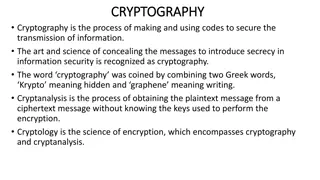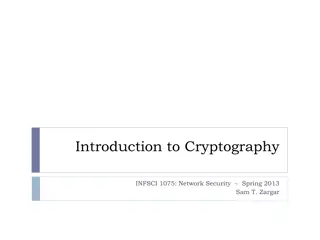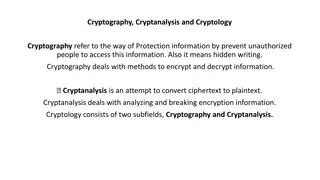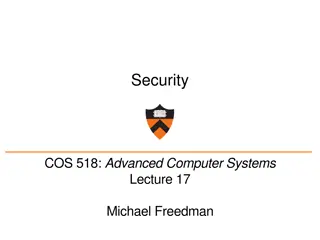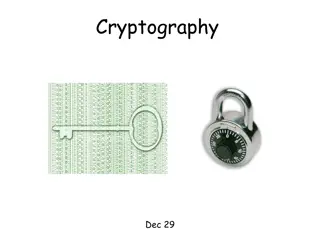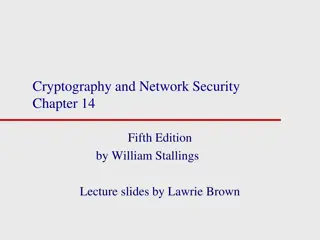Introduction to Cryptography: Basics, Terminology, and Significance
Cryptography is the study of techniques used for secure communication, involving creating programs to protect private messages. This overview covers the history, terminology, and significance of cryptography. Explore the basics, cyphers, and the importance of encryption in safeguarding sensitive data.
Download Presentation

Please find below an Image/Link to download the presentation.
The content on the website is provided AS IS for your information and personal use only. It may not be sold, licensed, or shared on other websites without obtaining consent from the author. Download presentation by click this link. If you encounter any issues during the download, it is possible that the publisher has removed the file from their server.
E N D
Presentation Transcript
+ + + + + + + + + + + + + Cryptography By: Isabel, Abby, and Sampreetha
;+; ;+; ; ;+; ;+; ;+; ;+; ;+; ;+; ;+; ;+; ;+; ;+; Table of contents 01 02 Basics Cyphers 03 04 Significance Protection
* ** ** ** ** * 01 The Basics of Cryptography In the next few slides we will cover the history of cryptography, along with some basic terminology and background information.
Termanology *:._.:*~*:._.:*~*:._.:*~*:._.:*~*:._.:*~*:._.:*~*:._.:*~*:._ Cipher Plaintext A secret or disguised way of writing; a code. Readable data including binary files in a form that can be utilized without the need for decryption. Encipher Decipher Convert (a message or piece of text) into a coded form; encrypt. Convert (a text written in code, or a coded signal) into normal language.
What is Cryptography: Cryptography- is the study of techniques for secure communication. More generally, cryptography is about creating and analyzing programs to prevent third parties or the public from retrieving private messages. Vocabulary: Crypto (prefix)- secure communication Bit and Byte- The bit is the most basic unit of information in computing and digital communications. A byte is 8 of these bits making it a larger unit of information
Note: There are traces of cryptography existing since the egyptians hieroglyphics Timeline: Herban rotating machines This machine was created by edward Herban as the first ever electric cipher device Advanced encryption standard AES replaced DES since it had crashed in 1997. AES used a symmetric-key algorithm with large bit key lengths. It became the national standard that year 1917 1977 2001 2023 Data Encryption Standard It was created to protect sensitive electronic government information using a symmetric-key algorithm and has a key-length of 56 bits. It became the federal information processing standard in the US. TLS Today we are protected while on the internet because of TLS. TLS uses asymmetric and symmetric encryption to ensure our information safety when on websites
Why was it invented? World War II Private Data Cryptography was intended for military purposes, and to hide secret military information Ensures the confidential transfer of private data Private key Encryption Confidentiality Insures that unauthorized users can not gain access to sensitive information When logging into websites your username and password is often encrypted before transmitted into web server
02 * *:. . .*. .:* *:. .*. Cyphers In the next few slides we will cover some popular cyphers, along with the Caesar cipher.
Types of Ciphers Transposition Cipher Substitution Cipher Plaintext Ciphertext Plaintext Ciphertext HOW? HOW? The encryption is done by changing the positions of the letters The encryption is completed by changing the letters Substitution cipher monoalphabetic cipher polyalphabetic cipher
. - : : : : - . - : : : : Caesar Cypher - Shift Cipher - Caesars Shift - Caesars Code x y z a a b b c c d d e e f f g g h h i i j j k k l l m m a b c d e f g h i j k l m n o p
Significance: It protects our privacy and keeps our conversation and data confidential This can all be programmed through algorithms that use symmetric key and asymmetric key algorithms. Core principles of cryptography: Data Confidentiality Data Integrity Authentication Cryptographer s can also play specialized roles that provide technical support to the government, and business to secure their data and prevent a data breach .
Protection Here we will look at how crypto is used in real life! Lets us know that this website it safe to use The Google lock: Located on the upper left hand of Small pieces of text sent to your browser by a website you visit. They help that website remember information about your visit. the google browser we have the lock icon Even through this lock is SSL/TLS (Secure Sockets Layer) certificates are what enable websites to use HTTPS. small the security and algorithm to ensure our What is a public key? In crypto there are 2 keys used when programing algorithms for security. Public and private keys. A public key can encrypt and only a private key can decode it An SSL certificate has the website's public key, as well as information specific to the site's identity. security are very complex
Sources The History of Cryptography | DigiCert Bits and Bytes Cryptography | Computer science Substitution cipher - Wikipedia Transposition cipher - Wikipedia What is an SSL certificate? | Cloudflare Public and private keys
Questions? artemis@bu.edu (617) 237-6189 https://www.bu.edu/lernet/artemis/index.html CREDITS: This presentation template was created by Slidesgo, including icons by Flaticon, and infographics & images by Freepik Please keep this slide for attribution
Thank you for listening!



